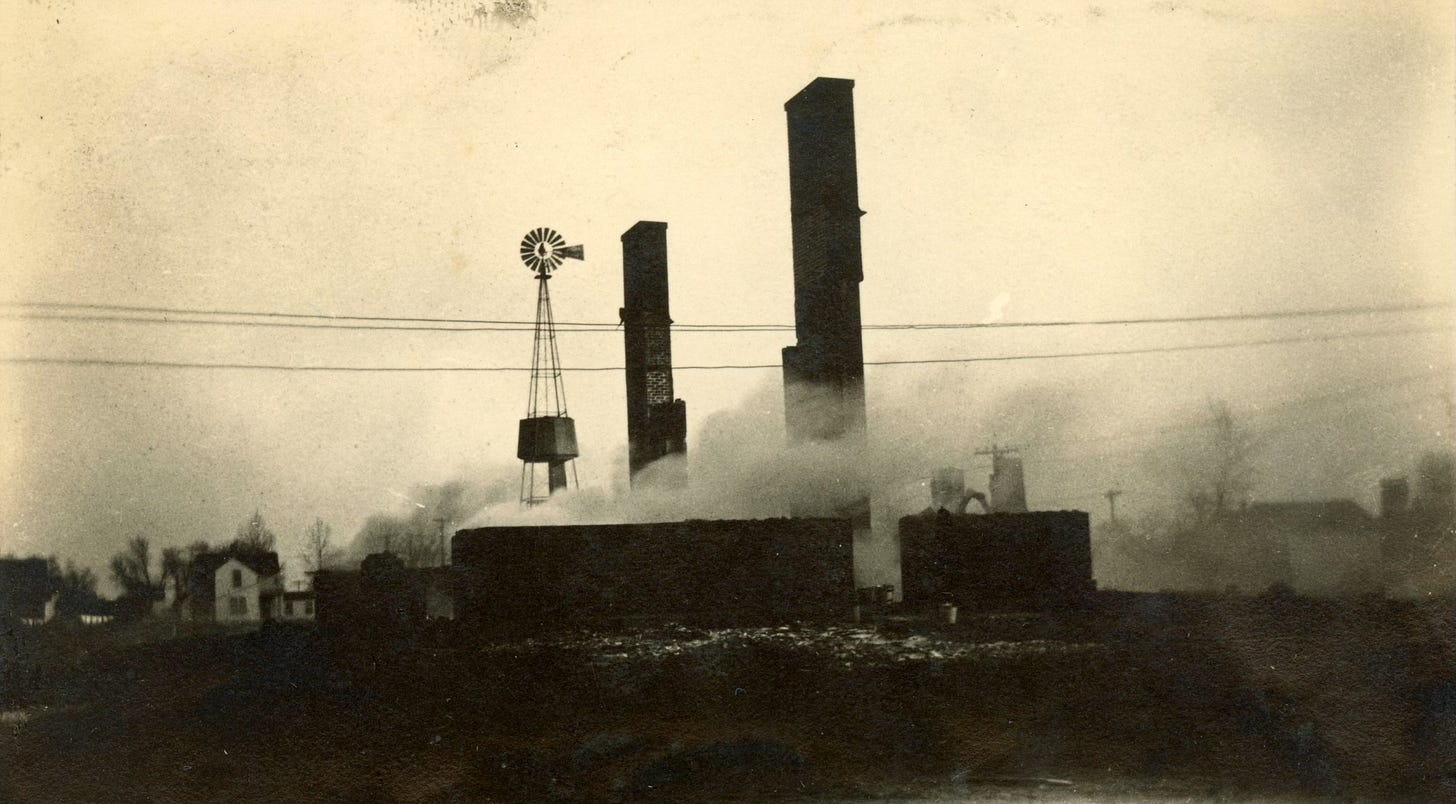
In January 1925, the Newburg Consolidated School District was set. Their high school building was only eight years old and considered “outstanding in this vicinity on account of its fine equipment and teaching force”.1 Three former country school houses, moved in and nestled closely around the high school building, served the elementary grades. And the new gymnasium, built just that fall, was a source of community pride. But things were about to change.
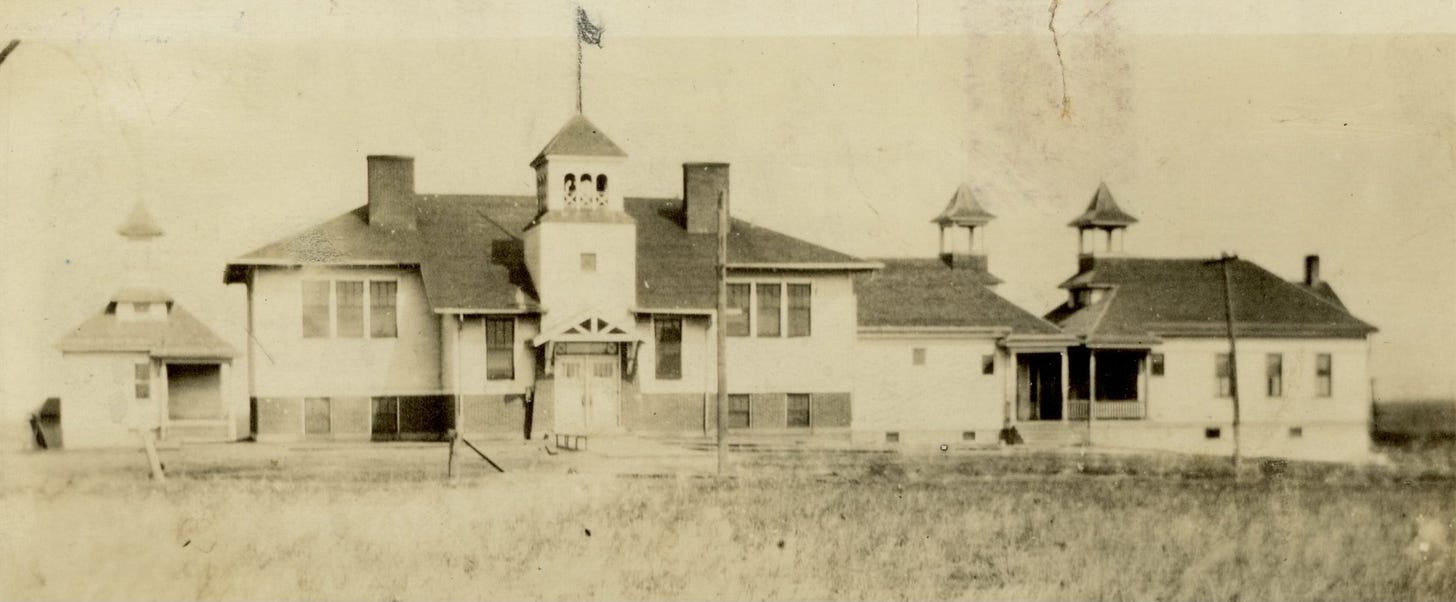
On Monday morning, 26 January, a fire started in the furnace room of the fifth and sixth grade building, the building nearest the high school building on the east side. According to the Grinnell Herald:
“The first intimation that anything was wrong was when one of the pupils, Letha Bailey, discovered the flames which had eaten through the floor. All the students were in their places but there was plenty of time for all to leave before there was any danger and there was no panic.”2
There was time enough, in fact, for one student, eleven-year-old Harley McIlrath, to run back into the burning building and get his coat.3
There was a high wind, apparently from the west, and the Grinnell Register reported that, “Although the whole community turned out to fight the fire, the strong wind and the headway gained combined to make an advantage which the stoutest efforts could not overcome.”4 Carried by the wind, the fire spread to the second school house on the east side of the high school building, the building that housed the third and fourth grades. According to the Herald, “a determined fight was made to save the high school and almost succeeded.”5 Help was called for from the Grinnell fire department, “However, they arrived too late to be of much assistance, as the buildings were practically consumed” by the time of their arrival.6 In the end, the high school building and the two school houses east of it were lost. The school house to the west of the high school building, which housed the domestic science department and the primary department, and the gymnasium were saved. The only reported injury was to Walter A. Palmer, the school’s janitor, who “was overcome by smoke while assisting in combating the flames and removing equipment, and had to be placed in a doctor’s care for a time.”7
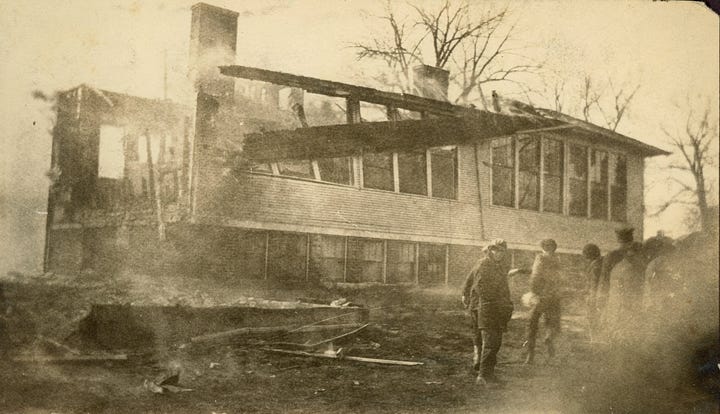
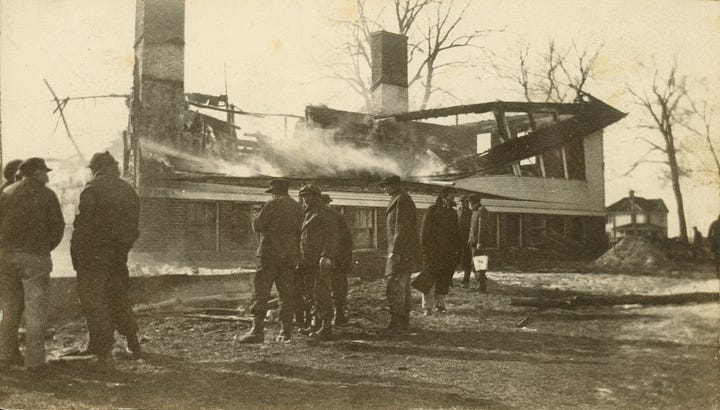
The late-arriving Grinnell fire department was the subject of controversy in the following days. In it’s coverage of the fire, the Grinnell Herald repeated a report that the Grinnell fire truck had left Grinnell but was delayed by bad roads.8 The Register, however, had already refuted that claim, saying, “The report that the fire truck left is not true, of course, as the truck is always kept in Grinnell.”9 In a retraction, the Herald clarified that:
“The Newburg people called the Grinnell Fire Company for help. Harry Case took his car with Will Laymiller and some others and the hand fire extinguishers and started for Newburg. Something gave way in the Case car a short distance north of town and it was necessary to telephone back for another car to finish the trip.”10
The Herald concluded, “Of course, it would be out of the question to take the fire truck that far from Grinnell over such roads unless the need was of a most unusual kind”.

The fire caused an estimated loss of $23,000 to the Newburg school district ($419, 590 in today’s dollars). The buildings were insured for $18,000, and the equipment was insured for $1,500.11 The people of Newburg wasted no time in looking to the future. The day after the fire, in the same article in which it reported the fire, the Grinnell Herald said, “For the present school will be continued in the gymnasium”,12 and three days after the fire, the Register reported that classes would resume “not later than next Monday”.13 Five days after the fire, the patrons and tax payers of the Newburg school district met in the gymnasium and agreed to hold a special election on 09 March to approve issuance of bonds totaling $40,000 ($729,722 in today’s dollars) to build and equip a new school building.14
Despite “considerable noise before the election of an expected opposition to the bond issue”, issuance of the bonds was approved by a vote of 111 in favor and 27 against.15 The Marshalltown Evening Times Republican reported that:
“The new building will be of brick, stone, steel and concrete construction, and will be fire proof. . . . When finished next summer, ready for occupancy in the fall, Newburg will have one of the finest consolidated school plants in the county.”16
The bonds were offered for sale by auction in the basement of the Newburg Congregational Church on 15 April 1925,17 and were purchased at 4 1/2 per cent interest with a $90 premium by George M. Bechtel & Company of Davenport. Competition for the bonds was described as “lively”,18 and the people of Newburg were “much elated over the excellent price they secured”.19
Another sort of sale had occurred in Newburg on 07 March 1925, the Newburg Annual Community Sale. Listed for sale at auction were such things as twenty head of horses and mules, sixty head of cattle, farm machinery, a threshing outfit, and two houses, one of which came with two lots in Newburg. Also listed was “[t]he entire wreckage of the Newburg Consolidated School Buildings, consisting of Brick, Cement Block, Furnaces, Etc.”20 The Herald reported that “[a] large crowd was present to make the occasion interesting and bidding was fairly good.” Ben Buck, who farmed south of Newburg, purchased the wreckage of the high school, and Anson Moxley, who owned a farm southwest of Newburg, bought the wreckage from the grade school buildings.21
With the wreckage cleared and the bonds sold, Newburg turned quickly to arranging the construction of a new building. Harry E. Reimers, the Marshalltown architect who had drawn the plans for the Newburg gymnasium, was hired to design the new school building, and on 21 April, the district published notice that it was accepting bids for the contract work.22 The contracts were awarded on 02 June. Whereas Grinnell firms had been awarded the contracts to build the original high school building in 1916, the contracts for work on the new building went entirely to Marshalltown firms. A bid of $35,900 won the general contractor job for C. F. Reimer & Co. The plumbing and heating contract went to the McCarten Plumbing Company on its bid of $9,100, and the lighting contract went to the Marshall Electric Company at $1,779. The contracts as let added up to a total cost $1,546 less than the amount estimated for the project by architect Reimers.23
Progress on the school building went mostly unreported. On 28 July, the Herald commented that Don See, Harry Ritter and Ralph Atkinson were working on the project. “The boys thought for a while that they were out of a job,” the paper said, “because they were laid off for a few weeks.”24 But work did progress, and a cornerstone laying ceremony was held on 01 August. The Newburg Double Quartet sang at the ceremony. County Superintendent of Schools Lucy E. Hall made remarks, and Ashel Murphy, president of the Newburg school board, recounted the history of the Newburg school. Before Rev. H. L. Wissler, pastor of the Chester Congregational Church, delivered his keynote address, rain broke up the outdoor gathering, and the event was moved into the gymnasium. There, Rev. Wissler praised the consolidated school movement. “He said it was not until the day of the consolidated school that higher education became possible for the farm children of the state. Now it is possible for all instead of the few.” When the rain subsided, the ceremony ended with the laying of the cornerstone by town father John Newcomer.25
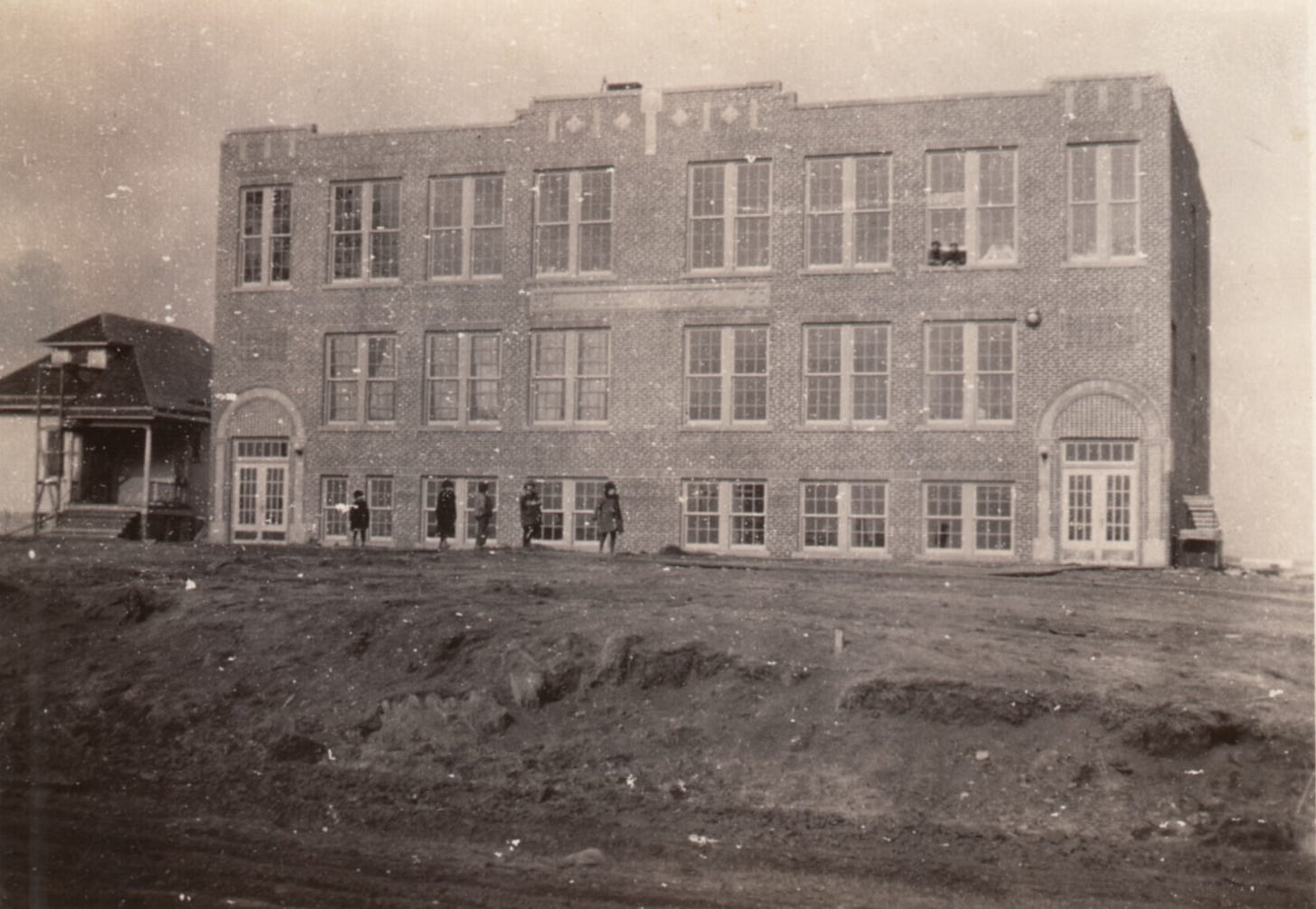
Fred Schell of the McCarten Plumbing Company was still working on the school house plumbing on 03 November 1925,26 and on 16 November, the school district advertised for a well digger.27 But on 03 December, the Jasper County Record reported that “[t]he Newburg school house is coming on very nicely. The teachers and pupils are expecting to move from the gym to the new building during Christmas vacation.”28 This they must have done as the paper said in its coverage of the dedication ceremony that “[t]he building has been in use since shortly after the holidays.”29 Interest in the new building seems to have been high. The paper noted in its 14 January 1926 issue that
"[t]here were many visitors during the past week at the Newburg school.”30
The dedication ceremony for the new school building was held on Friday, 19 March 1926. In the morning, architect Harry Reimers showed the 200 to 300 attendees around the new facility. At noon, a corn dinner was held in the gymnasium, and then district superintendent John Saysell presided over a service at which Jasper County Superintendent of Schools Lucy E. Hall again made remarks and school board president Ashel Murphy again recounted the history of the Newburg school. The dedicatory address, “The Message of the Occasion” was delivered by J. P. Ryan, professor of speech at Grinnell College. As reported by the Herald:
“The dedication in a word was ‘That here and now on this occasion we all re-dedicate ourselves to the great unfinished task of free public schools in order that the government of the people and by the people should not perish.’”31
With the ceremony concluded, “the parents and children boarded busses or clambered into horse drawn wagons to go to their homes”.32
“Newburg School is Fire Swept”, Grinnell Herald, 27 January 1925, p. 1.
Ibid.
From a family story told by my grandfather, Harley McIlrath, Sr. Asked why he risked going back into the burning building for his coat, he said, “It was the only coat I had.”
“Disastrous Fire Wrecks Newburg Schools”, Grinnell Register, 26 January 1925, p. 1.
“Newburg School is Fire Swept”.
“Disastrous Fire Wrecks Newburg Schools”.
“Will Rebuild School for the Fall Opening”, Grinnell Register, 29 January 1925, p. 1.
“Newburg School is Fire Swept”.
“Disastrous Fire Wrecks Newburg Schools”.
“Fire Truck Didn’t Start”, Grinnell Herald, 30 January 1925, p. 4.
“Will Rebuild School for the Fall Opening”.
“Newburg School is Fire Swept”.
“Will Rebuild School for Fall Opening”.
“Newburg to Hold Special Election”, Grinnell Herald, 03 February 1925, p. 1; Margaret Sullivan, “A Bond Proposition, Newburg, Iowa”, Grinnell Herald, 03 February 1925, p. 8.
“Garwin and Newburg to Build New Schools”, Evening Times Republican (Marshalltown, Iowa), 10 March 1925, p. 1.
Ibid.
Margaret Sullivan, “Notice to Bond Buyers”, Grinnell Herald, 24 March 1925, p. 8. The notice lists the assessed 1924 value of the district property as $1,749,848. The district owed $68,000 in debt, and the population of the school district was listed as 900.
“School Bonds Sold”, Evening Times Republican (Marshalltown, Iowa), 16 April 1925, p. 2. George M. Bechtel & Co. was a securities business mainly dealing with Iowa municipal bonds. At one time, it purchased and sold most of the municipal bonds issued in Iowa. The firm encountered financial difficulties during the depression.
“Newburg’s School Bonds are Sold”, Grinnell Herald, 17 April 1925, p. 1.
“Newburg Annual Community Sale”, Grinnell Herald, 03 March 1925, p. 6.
“Newburg Sale Totals $7,000”, Grinnell Herald, 10 March 1925, p. 1.
Margaret Sullivan, “Call for Bids for New Consolidated School at Newburg”, Grinnell Herald, 21 April 1925, p. 7.
“School Contracts Let”, Evening Times Republican (Marshalltown, Iowa), 02 June 1925, p. 3.
Grinnell Herald, 28 July 1925, p. 5.
“Will Lay Corner Stone at Newburg”, Grinnell Herald, 31 July 1925, p. 1; “Corner Stone is Laid at Newburg”, Grinnell Herald, 04 August 1925, p. 1.
Times Republican (Marshalltown, Iowa), 03 November 1925, p. 11.
Times Republican (Marshalltown, Iowa), 16 November 1925, p. 5.
“Newburg News”, The Jasper County Record (Newton, Iowa), 03 December 1925, p. 4.
“Dedicate New School”, The Jasper County Record (Newton, Iowa), 25 March 1926, p. 1.
“Newburg News”, The Jasper County Record (Newton, Iowa), 14 January 1926, p. 3.
“Dedicatory Exercises for Newburg Consolidated School”, Grinnell Herald, 23 March 1926, p. 1.
Ibid.


Corn dinner!! And what a brave and practical soul that McIlrath boy must have been. The fire may have been raging, but it’s cold in January!